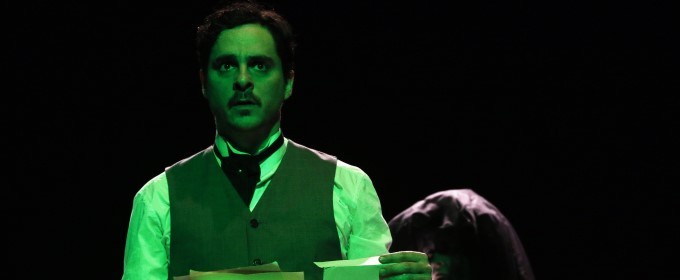Review: THE WOMAN IN BLACK at Theater Der Altstadt

Last weekend, Stuttgart's Theater der Altstadt welcomed the play The Woman in Black, a production directed by Gerhard Weber and brought to life by Bernhard Linke, Jörg Pauly and Tatjana Milicevic in the roles of Mr Kipps, the actor and the woman in black. The story became famous worldwide in 2012, when Daniel Radcliffe made his debuting performance in the horror genre with a movie that greatly surpassed expectations. The merit goes to both the young actor and to director James Watkins for a flawless performance and execution, but one should in no way overlook the quality and narrative strength of the original book. It did not take long before the tale was adapted to a stage play of great success, that is still, to this day, the second longest running non-musical play of the West End.
Weber made some interesting choices in his direction of The Woman in Black, the majority of which greatly paid off. When dealing with horror, and especially with a story that is now widely known, directors very often choose to focus on just that - the eerie and dark atmosphere that captures the breath of the audience. While that is fairly easy to achieve on the big screen, creating that effect in theatre is usually more complex. Remove the soundtrack and the sudden camera shifts and most horror movies become parodies of themselves. Unless the stage production is considerably large, or allows (often at great cost) for a non-rigid set, you will get one or two believable jump scares out of the crowd, with anything else coming primarily from character-built atmosphere, suspense-building dialog and lighting. Even then, one must be careful not to turn the play into a carnival fun house.
Instead, the director chose to invest on a mix of humour and scare, which worked out great. It is impossible to direct The Woman in Black without including a good deal of movement during confrontations with the ghost and travel scenes. When a small stage hosts a very sober horror play, as soon as characters are chased or decide to run, you very easily get yourself an awkward moment. And just like that, any set of props pretending to be a wagon or a chariot simply look goofy. In the way the show was built, however, a closet being used as a train compartment scored comedy points, rather than undermining an exclusively scary atmosphere. Another decision that proved particularly wise, was Weber's choice to keep the horror scenes separated from the comic ones, a mix that would have been legitimate, but turned the show into a Scary Movie kind of spoof.

For those unfamiliar with the play, it is one of the best conceived examples of "a story within a story." We are first introduced to Mr Kipps and the actor who agrees to help him tell his experience with the woman in black. Due to his apparent lack of acting talent, Mr Kipps is asked to leave his role to the actor and play instead every other person of relevance to his tale. He agrees and proceeds to embody countless characters, from his former employer to the town's innkeeper, all while interacting with an acted version of himself.
The challenges of the two actors on stage were notoriously different, yet both Linke and Pauly managed to pull off their parts with wonderful skill. Linke had to change characters not only often but also fast, yet all transitions felt remarkably natural and smooth, with every new figure being both believable and clearly distinct from the previous one. We would argue that the only moment Linke seemed to undersell was precisely in the role of a man who cannot act. Pauly, on the other hand, had the opposite challenge: invest in only one character, yet one that requires a much wider range of emotions and a much deeper development. The actor managed to do precisely this, in both moments of comedy and suspense. Given how often he interacted with his colleague's different personas, a natural temptation would have been to reflect these transitions in his own role, and lose the thread that made it unique. Pauly was flawlessly impermeable to this mistake and performed in the intended style of the show, delivering the right balance between humour and horror.
Congratulations to everyone involved in the project and all the best for future plays.
Image credit: Sabine Haymann
Videos
